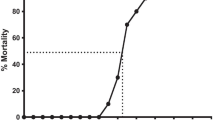Abstract
The effect of waterborne zinc on survival, growth, and feed intake of Indian major carp, Cirrhinus mrigala (Hamilton), advanced fry was studied under laboratory condition. Survival rates of C. mrigala advanced fry (2.71 ± 0.49 g) after 30 days exposure to control (0.01), 0.03, 0.06, 0.10, and 0.15 mg/L zinc using the static renewal method in freshwater at pH 7.3 ± 0.2, temperature 26 ± 2°C, and total hardness 114 ± 16 mg/L as CaCO3 were 100%. Growth of the fish exposed to 0.10 and 0.15 mg/L of zinc was significantly lower (P < 0.05) than in control (0.01), 0.03, and 0.06 mg/L of zinc after 30 days of exposure. However, there were no significant differences (P > 0.05) in fish growth between 0.03 and 0.06 mg/L zinc concentrations. Feed intake rates were significantly (P < 0.05) reduced in the fish exposed to 0.10 mg/L and higher levels of zinc. The zinc accumulation in the whole body of the fish increased with increasing concentrations of the metal.
Similar content being viewed by others
References
Alsop, D. H., McGeer, J. C., McDonald, D. G., & Wood, C. M. (1998). Costs of chronic waterborne zinc exposure and the consequences of zinc acclimation on the gill/zinc interaction of rainbow trout in hard and soft water. Environmental Toxicology and Chemistry, 18, 1014–1025. doi:10.1897/1551-5028(1999)018<1014:COCWZE>2.3.CO;2.
APHA (American Public Health Association) (1989). Standard methods for examination of water and wastewater, 17th Edition. American Public Health Association, American Water Works Association, Water Pollution Control Federation. Washington DC, USA: American Public Health Association.
Bengtsson, B. E. (1974). Effect of zinc on growth of the minnow, Phoxinus phoxinus. Oikos, 25, 370–373. doi:10.2307/3543958.
Brungs, W. A. (1969). Chronic toxicity of zinc to the fathead minnow, Pimephales promelas. Transactions of the American Fisheries Society, 98, 272–279. doi:10.1577/1548-8659(1969)98[272:CTOZTT]2.0.CO;2.
Crandall, C. A., & Goodnight, C. J. (1962). Effects of sub lethal concentrations of several toxicants on growth of the common guppy, Lebistes reticulates. Limnology and Oceanography, 7, 233–239.
Crandall, C. A., & Goodnight, C. J. (1963). Effects of sub lethal concentrations of several toxicants on growth of the common guppy, Lebistes reticulates. Transactions of the American Fisheries Society, 82, 59–73.
Eisler, R. (1993). Zinc hazards to fish, wildlife, and invertebrates: A synoptic review. US Fish and Wildlife Service Biological Report, 10, 106.
Glover, C. N., & Hogstrand, C. (2002). Amino acid modulation of in vivo intestinal zinc absorption in freshwater rainbow trout. The Journal of Experimental Biology, 205, 151–158.
Hogstrand, C., & Wood, C. M. (1996). The physiology and toxicology of zinc in fish. In E. W. Taylor (Ed.), Toxicology of aquatic pollution (pp. 61–84). Cambridge: Cambridge University Press.
Jhingran, V. G. (1991). Fish and fisheries of India (p. 727). Delhi, India: Hindustan.
Jhingran, V. G., & Khan, H. A. (1979). Synopsis of biological data on the mrigal, Cirrhinus mrigala (Hamilton, 1822). FAO Fisheries Synopsis No.120, Rome, p.78.
MacDonald, R. S. (2000). The role of zinc in growth and cell proliferation. The Journal of Nutrition, 130, 1500S–1508S, (review 6).
McCall, K. A., Huang, C.-C., & Fierke, C. A. (2000). Function and mechanism of zinc metalloenzymes. The Journal of Nutrition, 130, 1437S–1446S.
Powell, S. R. (2000). The antioxidant properties of zinc. The Journal of Nutrition, 130, 1447S–1454S.
Rath, R. K. (1993). Freshwater aquaculture (p. 267). Jodhpur, India: Scientific Publishers.
Shukla, J. P., & Pandey, K. (2006). Effect of a sub lethal concentration of zinc sulphate on the growth rate of fingerlings of Channa punctatus (Bloch), a freshwater murrel. Acta Hydrochimica et Hydrobiologica, 14, 677–680. doi:10.1002/aheh.19860140615.
Spry, D. J., & Wood, C. M. (1985). Ion flux rates, acid-base status, and blood gases in rainbow trout, Salmo gairdneri exposed to toxic zinc in natural soft water. Canadian Journal of Fisheries and Aquatic Sciences, 42, 1332–1341.
Talwar, P. K., & Jhingran, A. G. (1991). Inland fishes of India and adjacent countries, vol. 1 (p. 541). New Delhi: IBH.
Vallee, B. L., & Falchuk, K. H. (1993). The biochemical basis of zinc physiology. Physiological Reviews, 73, 79–118.
Watanabe, T., Kiron, V., & Satoh, S. (1997). Trace minerals in fish nutrition. Aquaculture (Amsterdam, Netherlands), 151, 185–207. doi:10.1016/S0044-8486(96)01503-7.
Watson, T. A., & McKeown, B. A. (1976). The effect of sub lethal concentrations of zinc on growth and plasma glucose levels in rainbow trout, Salmo gairdneri (Richardson). Journal of Wildlife Diseases, 12, 263–270.
Author information
Authors and Affiliations
Corresponding author
Rights and permissions
About this article
Cite this article
Mohanty, M., Adhikari, S., Mohanty, P. et al. Effect of Waterborne Zinc on Survival, Growth, and Feed Intake of Indian Major Carp, Cirrhinus mrigala (Hamilton). Water Air Soil Pollut 201, 3–7 (2009). https://doi.org/10.1007/s11270-008-9921-7
Received:
Accepted:
Published:
Issue Date:
DOI: https://doi.org/10.1007/s11270-008-9921-7




